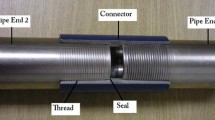Abstract
Chatter in the plug drawing of tubing is a common production problem which is manifest by visual and audible symptoms. Chatter can also produce subtle variations in product dimensions which may result in product rejection during final inspection. A model of this behavior based on stick-slip phenomena is developed for the purpose of identifying measures to reduce or avoid chatter. The measures suggested by this model are: increase draw velocity, increase spring rate of primary load carrying members (drawn tube and plug support rod), increase area reduction of draw pass, decrease tube material flow strength, and change in lubrication.
Similar content being viewed by others
References
E. Rabinowicz:Friction and Wear of Materials, Ch. 4, John Wiley and Sons, Inc., 1965.
C. A. Brockley and H. R. Davis:Trans. ASME, 1968, vol. 90, Series F, pp. 35–41.
Author information
Authors and Affiliations
Rights and permissions
About this article
Cite this article
Cook, C.S. A model of chatter due to stick-slip in the plug drawing of tubing. J. Applied Metalworking 1, 69–75 (1980). https://doi.org/10.1007/BF02833611
Issue Date:
DOI: https://doi.org/10.1007/BF02833611




